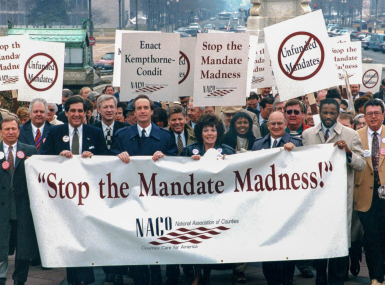The Death of Freddie Gray: Reflections from the Ground
Author

Hon. Helen L. Holton

Charlie Ban
Upcoming Events
Related News
 When life is going on as usual in a constant state of hurriedness to get things done, what does a county official do when you hit a bump in the road that has never been there before? That's what the past few weeks in Baltimore have been for the majority of currently serving elected officials in Baltimore City. Many were not born or not old enough to remember the unrest and riots of 1968 following the death of Dr. Martin Luther King, Jr. Unfortu nately, many of the underlying causes of the riots of 1968 are still present today.
When life is going on as usual in a constant state of hurriedness to get things done, what does a county official do when you hit a bump in the road that has never been there before? That's what the past few weeks in Baltimore have been for the majority of currently serving elected officials in Baltimore City. Many were not born or not old enough to remember the unrest and riots of 1968 following the death of Dr. Martin Luther King, Jr. Unfortu nately, many of the underlying causes of the riots of 1968 are still present today.
What messages have we heard and where do we go from here to rebuild and restore the lives of our citizens and our city?
As an elected official of my beloved city what have I learned from this crisis? How do we move forward? Can we move forward? We must.
These are all complex questions I've pondered since the death of Freddie Gray and the aftermath of what ensued. Today it is Bal timore in the spotlight, less than a year ago it was Michael Brown in Ferguson, Mo., Eric Garner in Staten Island, N.Y., and too many others to list here.
What county will be next? What are the warning signs? Is your county poised to be the next national headline news? I hope by sharing some of my reflections it may help another county official to be prepared for when the next outbreak occurs. I say "next" because I am convinced that until we begin to look realistically at our criminal justice systems and seriously consider reforms that are necessary to create an updated real ity, there will be another county on the world's stage of civil unrest with the potential to become violent.
On some level, issues such as poverty, unemployment, poor performing schools, inadequate housing, have not changed much over the last 50 years. Dr. King wrote in one of his last books, Where Do We Go From Here: Chaos or Community, "Laws are passed in a crisis mood after a Birmingham or a Selma, but no substantial fervor survives the formal signing of legislation. The recording of the law in itself is treated as the reality of the reform." Today it is important as county officials to really roll up our sleeves and go to work on the underlying issues that foster a ripe environment for what happened and is still happening in Baltimore.
Different from 50 years ago, though, is today's quick access to information. One can speak a statement in a closed meeting and while the meeting is going on that message can be on social media with video and sound coverage while the meeting is taking place. In attempts to break the latest news first, it appears journalists rarely spend the time and diligence of the past on fact checking, and misrepresentations are often not corrected or acknowledged as being false.
As county officials, it is im portant that we be more mindful of what we say and how we say it especially in the face of a crisis and in front of a camera. Sharing of information among all officials at the local, state and federal levels makes a difference and creates an atmosphere of unity and inclusion.
In a crisis, a unified front demonstrates to everyone the importance of the issue over and above anything else. We were successful in having local, state, and federal representatives on the ground and present with the protestors to help keep the peace and minimize further outbreaks of disobedience and violence.
Two officials that went above and beyond the call of duty to ensure the safety of citizens and addressing the needs of those di rectly impacted by the rioting were Congressman Elijah Cummings of the 7th Congressional District and City Council President C. Bernard "Jack" Young. Both of these leaders were in regular contact and on the ground with citizens demonstrating public service lead ership in a crisis. Whether it was getting citizens to go home before the time of curfew to avoid arrest or coordinating food and water delivery until more comprehensive efforts could be organized helped to bring calm to impacted riot victims.
Freddie Gray did not live in my district but he represents all the Freddie Grays of Baltimore over the years that fell victim to police brutality. This is not an indict ment of our police department as a whole, but it's important to note that in any large institutional organization there are more often than not a few bad players. Our police department as a whole does a good job protecting and serving the citizens of our city.
Recovery will be a long process and it is here where a county of ficial must look deeper than the obvious to determine what really caused the unrest. Police brutal ity is not new in Baltimore, and Freddie Gray is not the first person to lose his life at the hands of the police. This issue is beyond black and white. As I heard someone explain: It is a blue and green is sue. It's an issue of public safety and the criminal justice system (blue) and economic inequity or inequality (green).
As an active member of NACo I've learned some insightful, in novative and useful best practices, creative tools and opportunities to share within Baltimore to help us be more effective in delivering services and opportunities to our citizens.
The ability to build relation ships with county officials around the country and exchange ideas while discussing real issues has broadened my perspective in how to be more effective as a local leader, even in a crisis. Our active engagement with Capitol Hill and the White House was a valuable tool in my toolkit during this crisis to be able to share with my col leagues as we confront this issue.
Going through this experience had made me appreciate even more the many offerings NACo makes available to members. The NACo forums, conference learning opportunities, and quick access to legislative and research experts from among the NACo staff really serve as an extension of the resources available to my work as a local city (county) official in Baltimore. I'm grateful for NACo in helping me help my city, one of the greatest cities in America.
Attachments
Related News

CMS issues new guidance on Medicaid Community Engagement Requirements
On December 8, the Centers for Medicare & Medicaid Services (CMS) released a Medicaid and CHIP Services Informational Bulletin (CIB) directing states on how to implement the Medicaid community engagement requirements enacted under Section 71119 of the One Big Beautiful Bill Act legislation (Public Law 119-21), or H.R. 1.

U.S. House of Representatives passes SPEED Act and other permitting reform bills
On December 18, the U.S. House of Representatives passed the SPEED Act (H.R. 4776). The SPEED Act would strengthen county involvement in decision-making and make needed commonsense reforms to the federal environmental review process.
